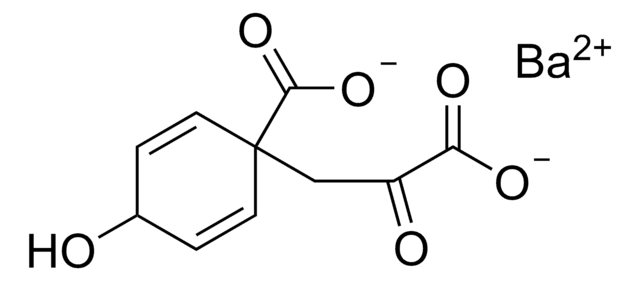114286
4-Hydroxyphenylpyruvic acid
98%
Synonym(s):
3-(4-Hydroxyphenyl)-2-oxopropanoic acid
About This Item
Recommended Products
Assay
98%
form
solid
mp
219-220 °C (dec.) (lit.)
solubility
ethanol: soluble 50 mg/mL
SMILES string
OC(=O)C(=O)Cc1ccc(O)cc1
InChI
1S/C9H8O4/c10-7-3-1-6(2-4-7)5-8(11)9(12)13/h1-4,10H,5H2,(H,12,13)
InChI key
KKADPXVIOXHVKN-UHFFFAOYSA-N
Looking for similar products? Visit Product Comparison Guide
Related Categories
General description
Application
<li><strong>Identification of serum biomarkers of ischemic stroke:</strong>4-Hydroxyphenylpyruvic acid is used as a potential diagnostic biomarker in the study to distinguish hypertensive ischemic stroke (IS) patients from both healthy individuals and those with hypertension (Zhao et al., 2023).</li>
</ul>
Preparation Note
Signal Word
Warning
Hazard Statements
Precautionary Statements
Hazard Classifications
Eye Irrit. 2 - Skin Irrit. 2
Storage Class Code
11 - Combustible Solids
WGK
WGK 3
Flash Point(F)
Not applicable
Flash Point(C)
Not applicable
Personal Protective Equipment
Regulatory Listings
Regulatory Listings are mainly provided for chemical products. Only limited information can be provided here for non-chemical products. No entry means none of the components are listed. It is the user’s obligation to ensure the safe and legal use of the product.
JAN Code
114286-5G:
114286-BULK:
114286-VAR:
114286-1G:
Certificates of Analysis (COA)
Search for Certificates of Analysis (COA) by entering the products Lot/Batch Number. Lot and Batch Numbers can be found on a product’s label following the words ‘Lot’ or ‘Batch’.
Already Own This Product?
Find documentation for the products that you have recently purchased in the Document Library.
Customers Also Viewed
Our team of scientists has experience in all areas of research including Life Science, Material Science, Chemical Synthesis, Chromatography, Analytical and many others.
Contact Technical Service









